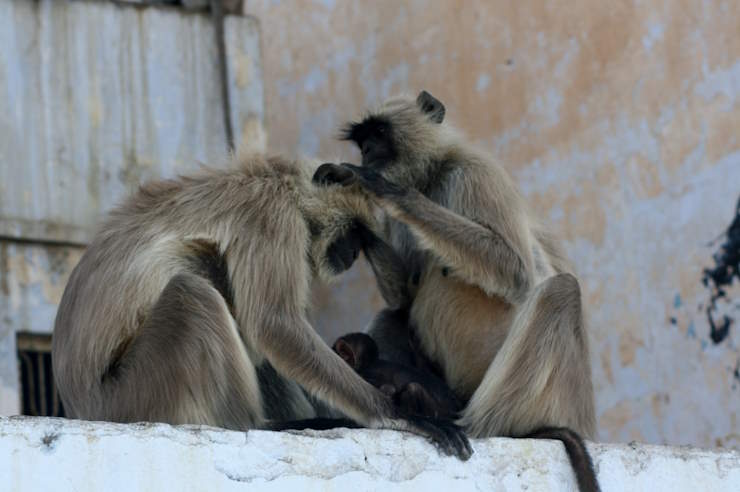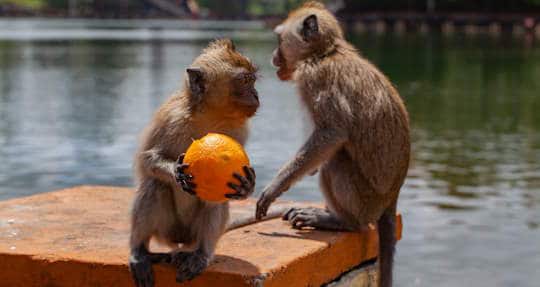When we think about evolution, we often view it as fierce competition, survival of the fittest, and selfishness in a struggle for resources. It’s every individual for themselves, right?
However, paradoxically, we often see selfless and altruistic behavior of animals in the natural world. they help each other, sometimes at their own expense—so how can this be?

In this blog post, I will explore how kin selection, a form of natural selection, can account for the selfless behaviors of animals in a selfish world dominated by natural selection.
So do animals indeed act altruistically? Yes, some examples include:
- flocking birds give alarm calls upon seeing predators, warning others but drawing attention to themselves
- nesting birds help their neighbors to fend off predators by attacking and mobbing them while risking their own lives
- worker bees and ants forego their reproduction for the benefit of the hive and the reproduction of the queen
- vampire bats regurgitate food for their colony members who are starving, leaving less nutrition for themselves
- meerkats (and other animals) gaze for the presence of predators while the rest of the pack enjoys a peaceful meal
- young birds assist in feeding new nestlings of their parents (humans do that too)
- chimps groom each other to form social bonds and mitigate parasite infestations
- squirrels adopt orphans of their deceased relatives
- and many more
Biologists propose an explanation known as kin selection. Although you may not be familiar with the term, kin selection is a concept in natural selection suggesting that animals are more likely to exhibit altruistic behavior towards their relatives.
The rationale behind the kin selection is simple: relatives share genes; thus, by promoting their survival, you indirectly facilitate the survival of your own genetic lineage.
Explaining kin selection: Your relatives are essentially you
This concept aligns with the inherent selfishness of survival. Your relatives are partially you; therefore, aiding them indirectly benefits you.
However, how much of you is in your relatives? What does it mean to be a part of you? You’ve likely heard that you share half of your genes with your siblings, but what exactly does that entail?
Humans possess nearly 21,000 genes, each with two versions in their DNA. This is because we, like many animals, have two sets of genes. The term “version” means that the entire gene is identical, but there are slight differences in the sequence of DNA that comprise it.
If you find this confusing, consider recapping this post to learn what DNA is.
Therefore, a certain gene might have hundreds of versions around the world, but you’ll have two of them in your DNA—one from each of your parents. This means you share half of your gene versions with each of your parents. In turn, they share half of their genes with your grandparents, resulting in you and your grandparents sharing 25% of all gene versions.
You also share half of your gene versions with your full siblings, who also received a randomly available gene version from the same parents. Cousins, being more distantly related, share only 12.5% of gene versions with you.
I won’t delve into more detail, but you can see how many gene versions you share with your relatives here. The crucial point is that your relatives share gene versions with you, and the quantity of shared gene versions depends on how closely related the relative is. But what does this imply for natural selection and survival of the fittest?
Survival of the fittest: Maximizing fitness
Survival of the fittest revolves around passing your genes down to the next generation. In evolutionary biology, this concept is known as fitness.
Fitness isn’t about physical prowess but rather an indicator of how well you’ve adapted to your environment. Simply put, fitness is a count of offspring that successfully reach maturity, though you should read more about fitness here.
Various events (and mishaps) can somewhat affect your future fitness. For instance, flirting lessons might enhance your chances of having children, improving your evolutionary fitness. Conversely, skipping a meal or consuming alcohol can reduce it.
The point is that different factors influence fitness by varying degrees.
Missing a meal might lead to some loss in fitness, but it’s generally insignificant if you eat the next one. However, dying dries fitness completely.
How relatedness affects fitness
If you share half of your gene versions with your children and the same proportion with your sibling, then one child is technically as valuable as one sibling from an evolutionary standpoint. This isn’t to suggest that an animal should sacrifice its offspring for a sibling, though in nature, such sacrifices occasionally occur.
In essence, it is acceptable for me to forfeit some fitness if it aids my sibling in gaining it. I can forgo a meal if my sibling is in dire straits.
This concept is known in evolutionary biology as inclusive fitness. It refers to a form of fitness that encompasses the fitness of others.
I have my personal fitness, but depending on relatedness, I also benefit to some degree from the fitness of my relatives because my gene versions are partly found in their genome.
In other words, I reap half of my sibling’s fitness gains (and bear half of their losses) and an eighth of my cousins’ fitness fluctuations.
Cost-benefit analysis of altruistic behavior
The principle of kin selection notes an essential point here. Altruistic behavior, which may cost you fitness but helps someone else gain it, does not necessarily come at a high cost.
What matters more is how much it costs you as a fraction of what your relative gains.
For example, suppose a relative asks me to help in their garden. This action is a fitness gain for my relative because they reap food from the garden. However, it is also a substantial fitness loss because I could have used that time to teach my children which mushrooms are safe to eat.
The question then becomes: how much fitness do I lose, and how much does my relative gain? Even though precise calculations are not feasible (since we do not have the numbers), there’s no doubt that amounts of fitness gained and lost exist inherently.
The crucial factor here is the degree of relatedness to the relative.
- For my sister, I will gladly lose half of what she gains. I can pay five dollars if it helps her get ten or more in return.
- For a cousin? No way, I’m not giving more than one and a quarter dollars. But still, it can be a deal.
In other words, the more distant the relative, the less I am interested in investing to perceive our “trade” as selfishly valuable to me.

If needed, this concept can be mathematically expressed: multiply the amount of fitness your relative gains by your degree of relatedness and subtract your fitness losses. Congratulations—you’ve increased your inclusive fitness if the result is greater than zero.
Of course, as previously stated, we do not know all the exact figures, so we can only estimate on a case-by-case basis and take a bit of a gamble. At the very least, we know who our relatives are and the degree of our relatedness to them. But can other animals gauge relatedness?
Can animals recognize their kin?
This question is difficult to answer, so let me clarify one thing.
In many instances, animals don’t need to assess relatedness consciously. Evolution by natural selection is a merciless process that penalizes inefficiency, regardless of an organism’s awareness.
We do not aid our relatives based on a calculated decision; we assist them because we feel it’s right. And why do we feel that way? Evolution has endowed us with this ability. Similarly, we don’t eat because we understand that not eating will lead to death. We eat because we feel hunger.
However, animals do possess the ability to recognize their relatives in several ways.
- Firstly, environmental clues can provide information. For example, if another animal resides in the same dwelling, it’s likely a relative. Many rodents, feral cats, and birds live in groups composed of related individuals. While not everyone in the group is guaranteed to be a relative, aiding someone from the same nest will usually result in more fitness gains than losses. From the perspective of natural selection, this is good enough.
- Secondly, genetic cues can also be revealing. Rodents, for instance, possess distinct body odors shaped by their genes. The more similar the genes, the more alike the odors. The same can be said about physical appearances. Do all your relatives share a striking green beard? Someone you meet with a similar green beard is probably your third cousin.
But what does it mean to recognize relatedness? Do animals need this ability, and can they even comprehend the concept of relatedness?
Does a mouse, knowing its sibling’s scent, acknowledge the similarity and act altruistically? Probably not. Maybe the rule is, if someone smells pleasant, I should be nice to them.
However, the question of whether animals recognize kin is not of primary importance. What truly matters is that assisting your relatives also provides evolutionary benefits to you.
Therefore, altruistic behaviors and help from seemingly ruthless animals do not contradict the principles of natural selection and survival of the fittest.
They align closely with these concepts since aiding your siblings, aunts, and cousins yields selfish benefits.